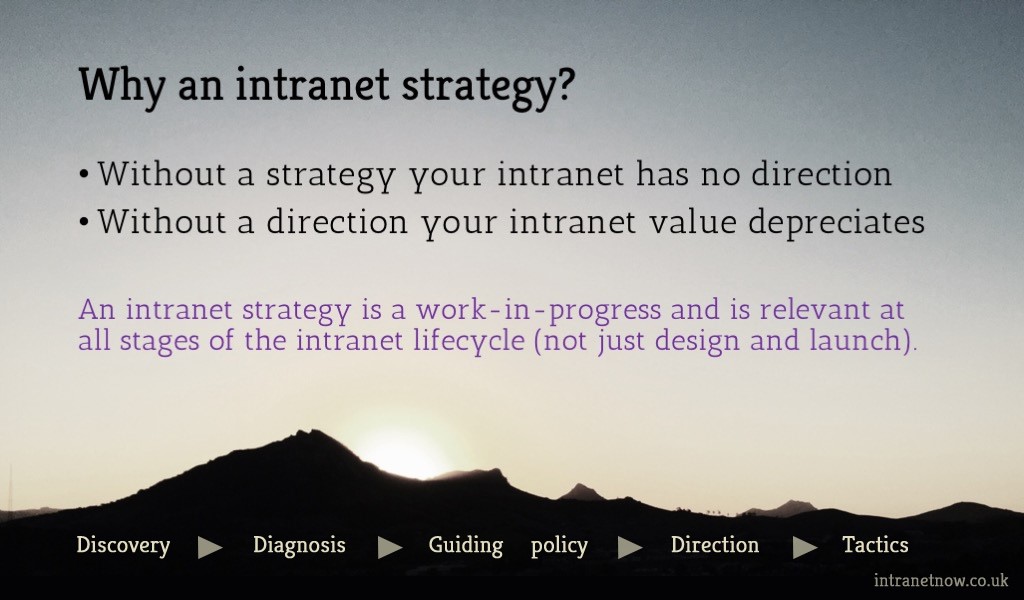 Why you should stop what you're doing and take time to make a strategy for your intranet
Why you should stop what you're doing and take time to make a strategy for your intranet
By Brian Lamb
January 25, 2016
Intranets can be one of the most useful assets in an organisation or they can become an unwieldy tangle of stuff, much of it useful, but lost amongst all the content and noise. As internal communicators we may find ourselves battling against the quantity of content, the numerous owners, the intractable restrictions of the systems we have as we try to make the intranet 'work' for our organisations.
We invited Brian Lamb of intranetNow to give us a brief overview of Intranet strategy
Over to Brian:
Why should busy teams spend precious time on making an intranet strategy? This was my first question when I met with
Steve Bynghall and Chris Tubb to discuss their approach to intranet strategy. The answer, is partly because you will be able to stop being so busy.
 Brian Lamb
Brian Lamb
Steve and Chris acknowledge that a lot of intranet teams work without a strategy, but two things tend to happen: First, you end up trying to do everything for everybody. Second, you won’t be seen as doing anything really valuable because all the reactive ‘busy work’ isn’t aligned to the big changes and goals of your organisation. A strategy helps you prioritise your task list based on a strong sense of direction.
To begin your strategy, you need to gather data about what is going on in your organisation. Not your opinion or your team’s opinion but some proper objective feedback. There are lots of sources for what Steve and Chris call the diagnosis stage of strategy making: surveys, focus groups, analytics, and interviewing stakeholders could all form part of the picture you are trying to build.
You need to take a close look at people’s everyday work to really understand how your intranet might help or hinder priorities within the business. Observing employees; guerrilla user experience and usability testing are all ways of putting yourself in their shoes.
The process might not be very comfortable; if your diagnosis just confirms your existing views it’s probably not going right; on the other hand, you should not end up with a bunch of complaints and problems either. A good diagnosis should identify opportunities to make a difference, save people time, increase efficiency, and develop employee engagement and satisfaction.
Diagnosis and discovery
•
Understanding problems is the only way to define the future path
•
Diagnosis is a period of research and analysis
•
Talk to stakeholders and employees
•
Gather internal and external data
•
Diagnosis is not requirements gathering.
By systematically identifying and collecting problematic symptoms you can begin to see where your intranet can add real value. Setting the overall direction delivers on one of the original benefits of strategy - helping you do more good work – If you have a clear direction (and management buy-in) you can say ‘no’ to projects and changes that don’t support the strategy. Providing your strategy is clearly aligned with organisation goals, and well communicated, people will understand that you are working alongside them in the right areas.

While team members must understand the difference between strategic and tactical plans, tactics have a vital place in that your everyday actions make your strategy a reality. Implementing a new technology is not a strategy, it’s a tactic. What’s the outcome that the technology is meant to deliver? It’s the result which should meet your strategic goals.
The intranet may be crucial for operational reasons, but your approach to continuous development will show senior managers how the intranet really adds strategic value instead of just being a cost centre.
Start the new year with a solid framework for your intranet’s evolution:
Formulating your intranet strategy: what’s your intranet direction?
Have you got a intranet story to tell? Overcome the challenges, created a strategy to wow and get results, we'd love to hear about it and share it here. Get in touch
[email protected]